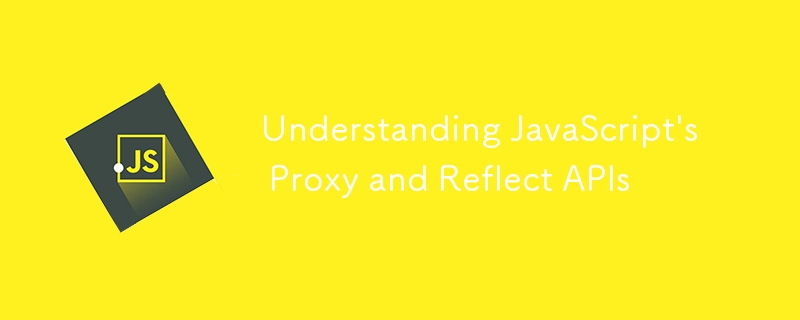Proxy and Reflect APIs are powerful tools used in JavaScript to intercept and customize object operations; 1. Proxy blocks operations such as get, set by wrapping target objects and defining "traps", and implements functions such as logs, verification, read-only control; 2. Reflect provides methods corresponding to Proxy traps to ensure the consistency and correctness of default behaviors and improve code maintainability; 3. Practical applications include Vue 3 responsive systems, data verification, debug logs, immutable objects and API simulation; 4. Pay attention to performance overhead, complex behavior of built-in objects, this binding problems, and nested objects need to be recursively proxyed; 5. Reasonable use can build an efficient, debugable, and reactive system, but excessive use should be avoided to make the code difficult to understand.

JavaScript's Proxy and Reflect APIs are powerful features introduced in ES6 that allows developers to intercept and customize fundamental object operations. While they might not be used every day, understanding them give you deeper control over object behavior and enables advanced patterns like validation, logging, and reactive programming.

What is the Proxy API?
A Proxy lets you create a wrapper around an object that can intercept and redefine basic operations like reading properties, writing values, or checking if a property exists. Think of it as a "gatekeeper" for an object.
Basic Syntax:

const proxy = new Proxy(target, handler);
-
target: The original object to wrap. -
handler: An object defining which operations to intercept (called "traps").
Example: Logging property access
const user = { name: 'Alice', age: 30 };
const proxy = new Proxy(user, {
get(target, property) {
console.log(`Getting property: ${property}`);
return target[property];
},
set(target, property, value) {
console.log(`Setting property: ${property} = ${value}`);
target[property] = value;
return true; // Must return true for successful assignment
}
});
proxy.name; // Logs: Getting property: name
proxy.age = 31; // Logs: Setting property: age = 31This is useful for debugging, validation, or even building observables.

Common Proxy Traps
Here are some frequently used traps in the handler:
-
get(target, property)– Intercepts property reads. -
set(target, property, value)– Intercepts property writes. -
has(target, property)– Interceptsinoperator (eg,'name' in obj). -
deleteProperty(target, property)– Interceptsdelete obj.prop. -
apply(target, thisArg, args)– Used for wrapping functions. -
construct(target, args)– Interceptsnewoperator.
Example: Validation with set trap
const validatedUser = new Proxy({}, {
set(target, property, value) {
if (property === 'age' && typeof value !== 'number') {
throw new TypeError('Age must be a number');
}
if (property === 'name' && typeof value !== 'string') {
throw new TypeError('Name must be a string');
}
target[property] = value;
return true;
}
});
validatedUser.name = 'Bob'; // OK
validatedUser.age = 'thirty'; // Throws TypeErrorThis allows you to enforce data integrity at the object level.
What is the Reflect API?
Reflect is a built-in object that provides methods for intercepting JavaScript operations. It's designed to work hand-in-hand with Proxy . For every proxy trap, there's a corresponding Reflect method.
Instead of manually accessing target[property] in a get trap, use Reflect.get() — it keeps the default behavior consistent and handles edge cases.
Why use Reflect?
- Keeps code clean and predictable.
- Handles
thisbinding correctly. - Provides a functional way to perform object operations.
Improved Proxy using Reflect:
const safeObject = new Proxy({ value: 42 }, {
get(target, property) {
console.log(`Accessing: ${property}`);
return Reflect.get(target, property);
},
set(target, property, value) {
console.log(`Mutating: ${property}`);
return Reflect.set(target, property, value);
}
}); Using Reflect ensures that your proxy respects JavaScript's default behavior unless explicitly overridden.
Practical Use Cases
These APIs aren't just academic — they're used in real tools and frameworks:
- Vue 3's Reactivity System : Uses
Proxyto detect property access and updates, replacingObject.defineProperty. - Validation Libraries : Wrap objects to enforce type or range checks.
- Debugging & Logging : Monitor object interactions without modifying the original code.
- Immutable Wrappers : Prevent accidental mutations by throwing errors in
settraps. - API Mocking : Simulate objects with dynamic responses.
Example: Read-only proxy
function readOnly(target) {
return new Proxy(target, {
set() {
throw new Error("Cannot modify a read-only object");
},
deleteProperty() {
throw new Error("Cannot delete from a read-only object");
}
});
}
const config = readOnly({ api: 'https://api.example.com' });
config.api = 'hacked'; // Throws errorGotchas and Best Practices
- Performance : Proxies add overhead. Don't wrap large objects unless necessary.
- Not all objects can be proxied equally : Built-in objects like arrays have nuanced behaviors.
- Use
Reflectconsistently : It makes your traps more reliable and easier to maintain. - Proxies only wrap the outer object : Nested objects aren't automatically protected unless you recursively proxy them.
Final Thoughts
Proxy and Reflect open up meta-programming capabilities in JavaScript. While overuse can make code harder to follow, they're invaluable for building clean abstractions, debugging tools, and reactive systems.
Used wisely, they let you write code that's both powerful and expressive.
Basically, if you need to observe, control, or enhance how objects behave — Proxy and Reflect are the tools to reach for.
The above is the detailed content of Understanding JavaScript's Proxy and Reflect APIs. For more information, please follow other related articles on the PHP Chinese website!

Hot AI Tools

Undress AI Tool
Undress images for free

Undresser.AI Undress
AI-powered app for creating realistic nude photos

AI Clothes Remover
Online AI tool for removing clothes from photos.

Clothoff.io
AI clothes remover

Video Face Swap
Swap faces in any video effortlessly with our completely free AI face swap tool!

Hot Article

Hot Tools

Notepad++7.3.1
Easy-to-use and free code editor

SublimeText3 Chinese version
Chinese version, very easy to use

Zend Studio 13.0.1
Powerful PHP integrated development environment

Dreamweaver CS6
Visual web development tools

SublimeText3 Mac version
God-level code editing software (SublimeText3)
 How to make an HTTP request in Node.js?
Jul 13, 2025 am 02:18 AM
How to make an HTTP request in Node.js?
Jul 13, 2025 am 02:18 AM
There are three common ways to initiate HTTP requests in Node.js: use built-in modules, axios, and node-fetch. 1. Use the built-in http/https module without dependencies, which is suitable for basic scenarios, but requires manual processing of data stitching and error monitoring, such as using https.get() to obtain data or send POST requests through .write(); 2.axios is a third-party library based on Promise. It has concise syntax and powerful functions, supports async/await, automatic JSON conversion, interceptor, etc. It is recommended to simplify asynchronous request operations; 3.node-fetch provides a style similar to browser fetch, based on Promise and simple syntax
 JavaScript Data Types: Primitive vs Reference
Jul 13, 2025 am 02:43 AM
JavaScript Data Types: Primitive vs Reference
Jul 13, 2025 am 02:43 AM
JavaScript data types are divided into primitive types and reference types. Primitive types include string, number, boolean, null, undefined, and symbol. The values are immutable and copies are copied when assigning values, so they do not affect each other; reference types such as objects, arrays and functions store memory addresses, and variables pointing to the same object will affect each other. Typeof and instanceof can be used to determine types, but pay attention to the historical issues of typeofnull. Understanding these two types of differences can help write more stable and reliable code.
 React vs Angular vs Vue: which js framework is best?
Jul 05, 2025 am 02:24 AM
React vs Angular vs Vue: which js framework is best?
Jul 05, 2025 am 02:24 AM
Which JavaScript framework is the best choice? The answer is to choose the most suitable one according to your needs. 1.React is flexible and free, suitable for medium and large projects that require high customization and team architecture capabilities; 2. Angular provides complete solutions, suitable for enterprise-level applications and long-term maintenance; 3. Vue is easy to use, suitable for small and medium-sized projects or rapid development. In addition, whether there is an existing technology stack, team size, project life cycle and whether SSR is needed are also important factors in choosing a framework. In short, there is no absolutely the best framework, the best choice is the one that suits your needs.
 JavaScript time object, someone builds an eactexe, faster website on Google Chrome, etc.
Jul 08, 2025 pm 02:27 PM
JavaScript time object, someone builds an eactexe, faster website on Google Chrome, etc.
Jul 08, 2025 pm 02:27 PM
Hello, JavaScript developers! Welcome to this week's JavaScript news! This week we will focus on: Oracle's trademark dispute with Deno, new JavaScript time objects are supported by browsers, Google Chrome updates, and some powerful developer tools. Let's get started! Oracle's trademark dispute with Deno Oracle's attempt to register a "JavaScript" trademark has caused controversy. Ryan Dahl, the creator of Node.js and Deno, has filed a petition to cancel the trademark, and he believes that JavaScript is an open standard and should not be used by Oracle
 Handling Promises: Chaining, Error Handling, and Promise Combinators in JavaScript
Jul 08, 2025 am 02:40 AM
Handling Promises: Chaining, Error Handling, and Promise Combinators in JavaScript
Jul 08, 2025 am 02:40 AM
Promise is the core mechanism for handling asynchronous operations in JavaScript. Understanding chain calls, error handling and combiners is the key to mastering their applications. 1. The chain call returns a new Promise through .then() to realize asynchronous process concatenation. Each .then() receives the previous result and can return a value or a Promise; 2. Error handling should use .catch() to catch exceptions to avoid silent failures, and can return the default value in catch to continue the process; 3. Combinators such as Promise.all() (successfully successful only after all success), Promise.race() (the first completion is returned) and Promise.allSettled() (waiting for all completions)
 What is the cache API and how is it used with Service Workers?
Jul 08, 2025 am 02:43 AM
What is the cache API and how is it used with Service Workers?
Jul 08, 2025 am 02:43 AM
CacheAPI is a tool provided by the browser to cache network requests, which is often used in conjunction with ServiceWorker to improve website performance and offline experience. 1. It allows developers to manually store resources such as scripts, style sheets, pictures, etc.; 2. It can match cache responses according to requests; 3. It supports deleting specific caches or clearing the entire cache; 4. It can implement cache priority or network priority strategies through ServiceWorker listening to fetch events; 5. It is often used for offline support, speed up repeated access speed, preloading key resources and background update content; 6. When using it, you need to pay attention to cache version control, storage restrictions and the difference from HTTP caching mechanism.
 Leveraging Array.prototype Methods for Data Manipulation in JavaScript
Jul 06, 2025 am 02:36 AM
Leveraging Array.prototype Methods for Data Manipulation in JavaScript
Jul 06, 2025 am 02:36 AM
JavaScript array built-in methods such as .map(), .filter() and .reduce() can simplify data processing; 1) .map() is used to convert elements one to one to generate new arrays; 2) .filter() is used to filter elements by condition; 3) .reduce() is used to aggregate data as a single value; misuse should be avoided when used, resulting in side effects or performance problems.
 JS roundup: a deep dive into the JavaScript event loop
Jul 08, 2025 am 02:24 AM
JS roundup: a deep dive into the JavaScript event loop
Jul 08, 2025 am 02:24 AM
JavaScript's event loop manages asynchronous operations by coordinating call stacks, WebAPIs, and task queues. 1. The call stack executes synchronous code, and when encountering asynchronous tasks, it is handed over to WebAPI for processing; 2. After the WebAPI completes the task in the background, it puts the callback into the corresponding queue (macro task or micro task); 3. The event loop checks whether the call stack is empty. If it is empty, the callback is taken out from the queue and pushed into the call stack for execution; 4. Micro tasks (such as Promise.then) take precedence over macro tasks (such as setTimeout); 5. Understanding the event loop helps to avoid blocking the main thread and optimize the code execution order.






